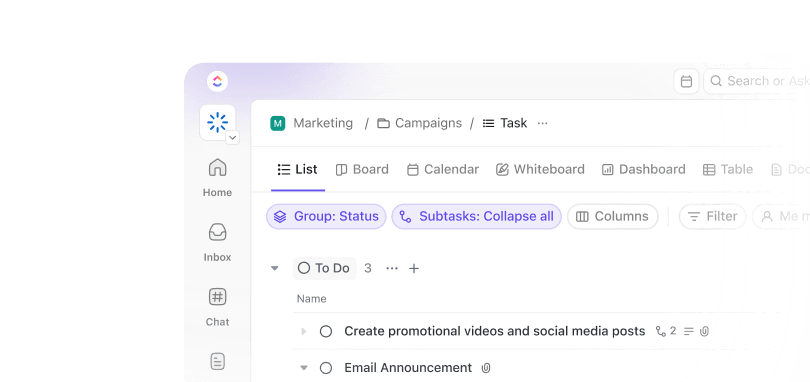Marketing demands can pull architects away from what they do best—designing.
Chasing leads, juggling campaigns, and tracking performance often means less time refining your craft and more time lost in tedious marketing tasks.
Mastering marketing strategies for architecture firms is all about focusing on the right tactics. These include defining your ideal clients, crafting compelling brand stories, and automating repetitive workflows. It’s knowing which channels truly showcase your expertise and which efforts quietly drain your resources.
In this blog, you’ll discover core marketing strategies for architecture firms and how to implement them.
How to Use Marketing Strategies for Architecture Firms to Stand Out
Why Marketing Is Essential for Architecture Firms
Marketing strategies for architecture firms have evolved far beyond hoping referrals will come through.
In a world of digital marketing strategies, relying solely on word-of-mouth, often called “hope marketing,” is no longer sustainable.
To thrive, firms must proactively build their brand, generate leads, and secure high-value prospective clients. Here’s why a robust digital marketing strategy is essential for architecture firms:
- Increased visibility and brand reach: Most clients start with Google searches and online reviews. A strong online presence makes your firm easy to find, driving more project inquiries
- Attracting high-value clients: Rather than waiting for calls, targeted marketing lets you engage and win premium projects by highlighting your unique expertise and successful case studies
- Cost-effectiveness and ROI: Digital channels, such as search engine optimization (SEO) and social media marketing, often outperform traditional ads while costing less. You can track performance and refine your approach to maximize ROI
- Lead generation and relationship nurturing: Systematic tactics—like downloadable design guides or webinar invitations—attract qualified leads. Automated email sequences keep prospects engaged long after their first visit
- Establishing authority and trust: Consistently sharing insights—through blog posts or a clear marketing communication strategy—positions your firm as a trusted resource and industry leader
- Competitive differentiation: In a crowded market, marketing showcases your firm’s unique value proposition—whether it’s sustainable design, luxury interiors, or commercial expertise—so clients know why to choose you
⭐ Featured Template
Want a quick way to define objectives, audiences, and channels and streamline a powerful marketing strategy for your architecture firm?
Try the Strategic Marketing Plan Template! It acts as your roadmap to attracting commercial or residential projects and gives you actionable ways to execute your plan in seconds!
Proven Marketing Strategies for Architecture Firms
Small and mid-sized firms need clear plans, especially considering the current crowded architecture market. Here are ten strategies to boost your reach and win more projects.
1. Defining your niche and positioning
Before spending on traditional architecture firm marketing, decide what you do best. Identify the services you excel at and the clients you want.
This clarity sharpens your firm’s brand. It also makes business development easier. When people know your specialty, they trust you sooner. A focused niche means every campaign speaks directly to potential clients.
That relevance increases response rates and cuts wasted efforts. Keep your messaging consistent across channels. Update your positioning as you learn more about market needs. A clear niche helps you stand out and command attention.
Real-life example: While Adbri Masonry is a building material manufacturer, they successfully showcased their “permeable pavers” through a collaboration on “The Good Day House,” a sustainable DIY project.
This focused on a specific product and a specific market segment (sustainable home builders/DIYers), allowing them to educate and inspire. The principle applies directly to architects who specialize in, say, mass timber construction or sustainable urban planning.
2. Networking and referrals
Personal outreach drives steady business development without big budgets.
Start by reconnecting with past clients and industry partners—consultants, contractors, even inspectors. Attend local mixers, workshops, and proposal-focused gatherings to meet new prospects. Focus on quality over quantity.
A single meaningful conversation can lead to a referral that covers months of effort. Keep notes on every interaction and follow up with a quick thank-you or insight. Over time, these small gestures build trust. Referrals also tend to convert faster because they come with a recommendation baked in.
3. Revisiting and nurturing old leads
It costs less to convert a warm prospect than to find a new one.
Use customer relationship management to track past inquiries, even the ones that didn’t close. Segment these contacts by interest, project type, or inquiry date. Then send targeted updates on recent work or helpful tips.
Monitor engagement and reach out when someone clicks a link or opens an email. This approach turns overdue leads into active opportunities. By keeping marketing efforts focused on people who already know your name, you boost response rates and build momentum for new projects.
Set up Custom Statuses and Custom Fields in to track every stage of your leads, from first inquiry to re-engagement. Use Custom Fields to segment contacts by what matters most—like interest or project type—so you can quickly filter and target the right people. This way, you’ll always know who to follow up with and can turn past prospects into new wins.
4. Website optimization and local SEO
Your site must showcase work while driving qualified traffic. Start by improving load times and mobile responsiveness. Here are some immediate things you can do:
- Add clear calls to action on every page
- Optimize your Google Business Profile and maintain consistent contact details across directories
- Use location-based keywords so searchers find you when they look for “architect near me”
- Track monthly website visitors to spot trends and adjust content accordingly
High-quality project photos and concise descriptions help prospects decide faster. A well-optimized site not only attracts clients but also earns trust before someone even emails or calls.
5. Content marketing through the client demand pyramid
You need an efficient content marketing management plan that plans, creates, distributes, and analyzes content to reach and engage your target audience effectively.
Most architectural firms focus their marketing on clients ready to hire, but that’s just the tip of the iceberg. According to the Client Demand Pyramid by The Business of Architecture, around 91% of potential clients are still researching or asking questions.
By creating informative, trust-building content for those in the early stages, you can nurture long-term interest. That way, when prospects are ready to hire, you’re already top of mind. Waiting until the final stage means competing for attention and trust all at once—often too late to win them over.
📮 Insight: According to our survey, nearly 88% of leaders still rely on manual check-ins, dashboards, or meetings to get updates.
The cost? Lost time, context-switching, and often, outdated information. The more energy you spend chasing updates, the less you have for acting on them.
’s Autopilot Agents, available in Lists and Chats, surface status changes and critical discussion threads instantly. Here’s to never having to ask your team to send “quick updates”. 👀
💫 Real Results: Pigment improved team communication efficiency by 20% with —keeping teams better connected and aligned.
6. Social media engagement
Social platforms let you show personality and projects in real time. Choose channels that match your audience: LinkedIn for professional updates, Instagram or Pinterest for visuals. Post project snapshots, behind-the-scenes stories, and short design tips. Engage with followers by responding to comments and questions promptly.
A good way to maximize effectiveness is to use platform insights to see which posts drive the most engagement. Then adjust your content accordingly. This ongoing conversation builds relationships and encourages shares. When done well, social media supports your firm’s growth by amplifying word-of-mouth and driving new inquiries without a big ad spend.
Zaha Hadid Architects effectively “Utilises Social Media to Drive Traffic,” specifically Instagram. They showcase “beautiful images and videos of their past and present projects,” which has built an “avid following” and allowed them to directly link to articles and content on their website via Facebook. Their large, engaged social media following is a testament to their visual content strategy.
7. Email newsletters
Want to turn casual website visitors into loyal fans—and future clients? Start with a simple newsletter. Add an easy-to-spot signup form to your footer and project pages. Then, send out monthly or bi-monthly emails with things people actually want to read—like your latest projects, fresh design ideas, and helpful tips.
You can even tailor the content based on what they’re into, whether it’s residential homes or commercial builds. With a little help from marketing automation, you can send smart follow-ups when someone clicks a link or downloads something from your site—without lifting a finger.
💡 Pro Tip: Want to start your own real estate newsletter? Kick off your newsletter with ’s Real Estate Newsletter Template! It’s designed to help you create stunning, customized updates for your clients and prospects fast. Stand out, engage your audience, and grow your leads—all from one easy-to-use template.
8. Paid advertising and ROI tracking
Running paid ads can be a great way to boost your leads—but only if you keep an eye on what’s actually working. Before you launch anything, get clear on your goal.
Do you want more consultations, brochure downloads, or event signups? Put your budget into local search ads and social ads that target the right people, like folks with specific job titles or interests.
Then, do the math. How much are you spending per lead? Is that lead worth it based on your usual project value? Don’t be afraid to pause or tweak campaigns that don’t measure up. Checking in regularly helps you make smarter ad decisions—and protects your budget from going to waste.
9. Event marketing and thought leadership
If you want to get noticed in your industry, start showing up and speaking out. Present at events or host workshops on topics you know well—think adaptive reuse, sustainable design, or whatever sets your projects apart. Don’t just talk; bring visuals and results from past work.
Afterward, follow up with attendees—share a helpful resource or recap the event on your blog and social media. Each event builds your reputation as an expert and makes referrals more likely. It takes prep, but it’s worth it: the leads you gain tend to come warmed up and ready to talk.
For instance, on the other side of the world, firms like Studio Mumbai‘s showcase at MPavilion in Melbourne, Australia, have gained global recognition through exhibitions and publications that highlight their craftsmanship.
10. Public relations and self-publishing
Press coverage doesn’t happen by accident—you need to pitch it. Come up with angles that spotlight the best of your work: maybe a new building material you used, a cool community story, or a tricky design challenge you overcame. Share those stories with local media, industry outlets, or blogs your clients read.
Or take matters into your own hands: publish insights or white papers on your website. Send them to design magazines. Thoughtful content builds credibility, gets shared, and earns you backlinks. Over time, this raises your profile and builds trust—all without a big ad budget.
Bonus: Managing your own business is hard work. But not with the right support. Get insights from your business efficiently! Here’s how.👇🏼
11. Adopt new technologies
Differentiate your firm by integrating cutting-edge tools into your presentations. Offer VR walkthroughs or interactive 3D models during pitches. These experiences let prospects explore designs intuitively. Highlight technology in your marketing materials to show innovation. Train your team so demos run smoothly.
While the investment can be significant, early adopters stand out in competitive bids. Make sure the tech enhances understanding rather than distracting from your core message. When executed correctly, advanced demos underscore your technical expertise and can tip decisions in your favor.
Snøhetta used VR for the San Francisco Museum of Modern Art (SFMOMA) expansion, specifically for optimizing energy performance. Showcasing such innovative use of technology in project development serves as a powerful marketing tool, attracting clients who value cutting-edge solutions and efficiency.
12. Create an integrated marketing plan
Bring all tactics together with a single marketing plan. Start by setting clear objectives—lead volume, project type, or revenue targets. Map each strategy to these goals and assign timelines. Utilize tools such as project trackers or simple spreadsheets to track progress. Schedule regular reviews to assess performance and adjust priorities.
An integrated plan ensures you maintain balance between immediate wins and long-term growth. It also prevents redundant efforts and keeps your team aligned. Though planning takes time, a coordinated approach amplifies each tactic’s effectiveness and helps your firm scale sustainably.


👀 Did you know? A case study of an architecture firm active on Instagram and LinkedIn revealed a 20% increase in project inquiries within six months after sharing behind-the-scenes content that showcased their design process. This highlights the power of storytelling and transparency in architectural marketing.
How Can Support Architecture Marketing
Architecture firms must juggle design, client relations, and marketing tasks. , the everything app for work, centralizes these efforts. It offers tools to streamline workflows, enhance collaboration, and track performance. Below are key ways can transform your marketing.
Centralized project management for every campaign


for Marketing Teams is the command center for your entire marketing strategy.
You can create a dedicated Space for marketing, organize Folders by focus areas—such as residential projects, commercial outreach, PR, and digital ads—and use Lists for individual campaigns.
This structured hierarchy helps marketing teams manage content calendars, client communications, social media, and proposal development without getting lost in the chaos.


Use Custom Views in to switch between List, Board, Calendar, or Gantt views to visualize each project phase. From high-level planning to task-level execution, gives your team a shared view of what’s happening and what’s next.
👀 Did you know? The U.S. architectural services market is driven by the increasing demand for sustainable and energy-efficient buildings. This prompts architecture firms to highlight their expertise in green design and innovative solutions as a key marketing strategy to attract both commercial and residential clients.
Seamless collaboration and real-time communication


The most important thing to remember about marketing is that it doesn’t happen in silos. With Docs, Whiteboards, and the built-in Chat, architecture teams can work together in real time on proposals, press kits, and presentation decks.
Use comment threads and @mentions to gather feedback from partners, clients, or design leads directly on drafts, images, or layouts. No more scattered email chains or missed updates!
Furthermore, the Proofing feature provides clear and structured feedback on visual content. Move your marketing materials and design assets quickly from concept to approval.
Smarter content management and publishing workflows
makes content marketing super easy to plan and scale. Whether it’s social posts, blogs, or email newsletters, you can manage editorial calendars, track asset status, and assign tasks to different team members—all in one place.
Want to move faster? Tap into ’s AI, Brain! Ask natural language questions to find project details, proposals, or past campaign assets instantly. It helps instantly generate blog ideas, email copy, or social captions tailored for architecture firms and can summarize long updates or meeting notes in seconds. You can even use multiple LLMs, like Claude, Gemini, and more, to spin up brand new content ideas!
Then, use Automations to trigger next steps (like scheduling posts or follow-up emails) so campaigns keep moving even when you’re focused on client projects.


You can also employ AI Agents to act as your behind-the-scenes marketing coordinators. They automate the busywork so your architecture team can focus on creativity and clients.
Agents can auto-assign Tasks, update project Statuses as you hit Milestones, and even send Reminders for proposal deadlines or portfolio updates. They’ll move leads through your CRM as interest grows, trigger follow-up emails after someone fills out a form, and alert your team when feedback or approvals are needed.
It’s smart, hands-free marketing support that keeps everything running smoothly, without the constant checklists.
Speaking of keeping things smooth and saving time, templates are the ultimate way to ensure your marketing strategies are on point. For example, the Marketing Campaign Template helps architecture firms stay organized, aligned, and data-driven in one place.
With this template, you can:
- Outline key initiatives like email blasts, social media pushes, and event promotions
- Set up a structured system by creating a dedicated “Campaigns” Space, then add separate Folders for “Social Media,” “Email Marketing,” and “Paid Advertising”
- Track specific tasks, deadlines, and assets tied to each effort
- Use a checklist for each launch—think items like “Finalize design mockups,” “Approve ad copy,” and “Set Google Ads budget”
- Visualize progress using the Kanban Board View, where Tasks move from “To Do” to “Completed”
- Create a “Campaign Debrief” task to reflect on what worked, what didn’t, and how you can improve the next round
Insight-driven performance and reporting


’s custom Dashboards let you track KPIs like website traffic, lead conversions, and email engagement at a single glance. You can build visual widgets to monitor team capacity, campaign timelines, or content calendars, and adapt quickly when priorities shift.
The built-in reporting and analytics help you understand what’s working and what’s not, so you can double down on high-impact efforts.
Integrations that fit into your marketing stack
Beyond all the features that help in architecture marketing, connects seamlessly with the tools your team already uses. These include Google Drive, Slack, HubSpot, Figma, Dropbox, and more.
Whether you’re collaborating with designers, syncing with sales, or storing high-res project visuals, everything stays in sync!
Madeleine S., a marketing coordinator at a mid-market firm, reviews on G2:
Common Marketing Mistakes to Avoid
A solid marketing approach avoids common pitfalls that waste time and money. Address these mistakes to ensure your efforts yield real results.
Ignoring your target market
Knowing who you serve is essential. When firms treat every lead the same, they waste time and money. Residential clients and commercial developers have different priorities. Without researching budgets, project goals, and pain points, campaigns become generic and fail to resonate. Updating strategies based on feedback ensures you stay aligned with evolving client needs.
Neglecting your digital presence
Clients expect a modern firm to be visible online. An outdated website with broken links or missing mobile optimization damages credibility. Ignoring SEO means your firm won’t rank for “commercial architecture” or “residential design,” leading to lost organic leads. Claim local listings and keep site content fresh to attract and retain visitors.
Inconsistent branding
Mixed visuals and messaging confuse prospects. Using multiple logo versions or varying color schemes dilutes brand recognition. Formal proposals and casual social posts should share a unified voice and style. Without documented brand guidelines, team members make ad hoc design decisions, resulting in disjointed marketing collateral.
Failing to measure performance
Data guides improvements. Without defined KPIs—such as “20 leads per month”—firms cannot gauge success. Skipping tools like Google Analytics leaves you blind to traffic sources. Gathering data irregularly means that underperforming tactics go unnoticed. Regular reviews allow timely adjustments and better resource allocation.
Overlooking content quality
Low-value content harms authority. Shallow blog posts without visuals or case studies fail to engage readers. Writing about your awards instead of addressing client problems misses the mark. Sporadic posting leads to inconsistent traffic and waning interest. High-quality, relevant content builds trust and converts prospects.
Underutilizing social media platforms
Social channels amplify reach and networking. Focusing on the wrong platforms or posting irregularly leads to low engagement. Sharing without responding to comments or messages kills conversation. Ignoring features like Stories or LinkedIn Articles limits visibility. Consistent, interactive posting boosts follower loyalty and lead generation.
Not leveraging CRM and automation
Manual tracking slows follow-up and lets leads slip away. Relying on spreadsheets instead of automated systems introduces errors and missed reminders. Without centralized lead data, prospects scattered across email or notes risk being forgotten. Segmentation tags and automated reminders keep communication relevant and timely.
Relying solely on traditional marketing
Print ads and billboards still matter but cannot replace digital tactics. Skipping email or social campaigns limits touchpoints with prospects. Hosting events without digital promotion yields low turnout. Failing to measure ROI on print collateral means you never know if a magazine ad generated inquiries.
Lack of a solid marketing strategy
Without a clear roadmap, tactics become random and ineffective. No defined goals—such as “increase website leads by 30%”—create confusion. Ad hoc campaign launches waste time and budget. Missing budget allocation or accountability means tasks fall through the cracks and resources are misused.
Poor follow-up with leads
Delayed responses allow competitors to swoop in. Sending generic thank-you emails lacks personalization and fails to build rapport. Leads who download a guide but receive no further information grow cold. Without a nurture sequence or periodic check-ins, opportunities are wasted, and potential projects disappear.
Boost Effective Marketing Strategies for Architecture Firms with
In a competitive industry where timelines are tight and impressions matter, gives architecture firms the edge they need to plan, execute, and track their marketing efforts—all from a single platform.
From managing content calendars and automating client follow-ups to collaborating on proposals and analyzing campaign results, brings clarity, structure, and speed to your marketing workflow. Whether you’re a small firm or a growing studio, adopting means spending less time juggling tools and more time building a brand that wins business.
Build trust. Deliver quality. Attract new clients. Win bigger projects. Sign up for today!


Everything you need to stay organized and get work done.














